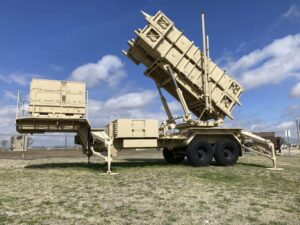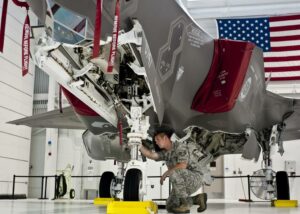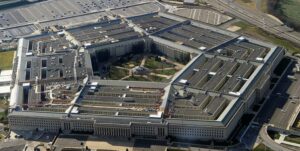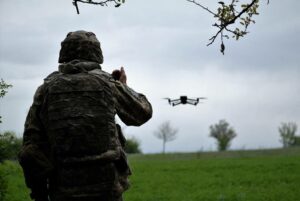BALTIMORE — The increasing intricacy of military networks and the digital savvy of other world powers is making artificial intelligence and related programs more desirable for U.S. cyber leaders.
With an explosion of high-tech devices and vehicles and the vast amount of data they pass back and forth come additional security and responsiveness demands. And “anything we can do to buy down that complexity,” by employing AI and machine learning, “would be absolutely fantastic,” according to Lt. Gen. Maria Barrett, the leader of Army Cyber Command.
“We fly planes on autopilot, we land on autopilot,” she said May 2 at the AFCEA TechNet Cyber conference in Baltimore. “This is not scary to run a network in an automated way.”
Automation is a key piece of the Pentagon’s adoption of zero trust, a new cybersecurity paradigm. The approach assumes networks are jeopardized, requiring perpetual validation of users, devices and access. The practice is often likened to “never trust, always verify.”
Defense officials have imposed a fiscal 2027 deadline to implement a level of zero trust, which totals more than 100 activities, capabilities and so-called pillars.
ΣΧΕΤΙΖΕΤΑΙ

“Zero trust is all about looking at the data. It’s not just about the human being who logs in as an identity because, at the end of the day, that is a data element,” Barrett said. “We do, really, need to get to this place where we’re now starting to think about looking for the anomalous data that occurs in several different aspects of our network in order to identify where the adversary is much sooner, and, going back to my AI and ML piece, in an automated way.”
The U.S. considers China and Russia its most significant cyber threats. Iran and North Korea also make the list, to a lesser degree, as do other autocratic states.
Monitoring all the digital nooks, crannies and potential backdoors and loose ends is already a demanding task, made more so by “the plethora of devices out there that generate traffic,” according to Maj. Gen. Joseph Matos with Marine Corps Forces Cyberspace Command.
“You have planes, you have weapon systems, you have vehicles, they’re all generating data, they’re all generating information,” he said at the same event where Barrett spoke. “Now, how do you keep track of all that, and how do you manage all that data? Even with zero trust, that’s just an awful lot.”
More than 685 AI projects were underway at the Pentagon as of 2021, the most recent public tally. At least 232 efforts are being handled by the Army, according to το Γραφείο Λογοδοσίας της Κυβέρνησης, a federal watchdog. The Marine Corps is dealing with at least 33.
Ο Colin Demarest είναι ρεπόρτερ στο C4ISRNET, όπου καλύπτει στρατιωτικά δίκτυα, κυβερνοχώρο και πληροφορική. Ο Κόλιν κάλυψε προηγουμένως το Υπουργείο Ενέργειας και την Εθνική Διοίκηση Πυρηνικής Ασφάλειας - συγκεκριμένα την εκκαθάριση του Ψυχρού Πολέμου και την ανάπτυξη πυρηνικών όπλων - για μια καθημερινή εφημερίδα στη Νότια Καρολίνα. Ο Colin είναι επίσης βραβευμένος φωτογράφος.
- SEO Powered Content & PR Distribution. Ενισχύστε σήμερα.
- PlatoAiStream. Web3 Data Intelligence. Ενισχύθηκε η γνώση. Πρόσβαση εδώ.
- Minting the Future με την Adryenn Ashley. Πρόσβαση εδώ.
- πηγή: https://www.defensenews.com/cyber/2023/05/03/us-cyber-leaders-look-to-ai-to-augment-network-activities/
- :έχει
- :είναι
- :δεν
- :που
- 1
- 100
- 11
- 2021
- 70
- a
- Σχετικά
- απολύτως
- πρόσβαση
- Σύμφωνα με
- ευθύνη
- δραστηριοτήτων
- Πρόσθετος
- διαχείριση
- Υιοθεσία
- προηγμένες
- AI
- αεροσκάφος
- Όλα
- ήδη
- Επίσης
- πάντοτε
- ποσό
- an
- και
- πλησιάζω
- ΕΙΝΑΙ
- Στρατός
- τεχνητός
- τεχνητή νοημοσύνη
- καλλιτέχνης
- AS
- πτυχές
- At
- επίθεση
- Αυτοματοποιημένη
- αυτόματο πιλότο
- βραβευμένο
- πίσω
- Κερκόπορτες
- Βαλτιμόρη
- BE
- επειδή
- ήταν
- είναι
- χτίζω
- αγορά
- by
- CAN
- δυνατότητες
- Κίνα
- κρύο
- Ελάτε
- περίπλοκο
- Διάσκεψη
- θεωρεί
- Εργολάβος
- καλύπτονται
- Καλύπτει
- στον κυβερνοχώρο
- Κυβερνασφάλεια
- κυβερνοχώρο
- καθημερινά
- ημερομηνία
- ημέρα
- μοιρασιά
- Πτυχίο
- απαιτητικές
- απαιτήσεις
- Τμήμα
- Υπουργείο Ενέργειας
- Ανάπτυξη
- Συσκευές
- διαφορετικές
- ψηφιακό
- do
- κάτω
- προσπάθειες
- στοιχείο
- τέλος
- τελειώνει
- ενέργεια
- Αιθέρας (ΕΤΗ)
- Even
- Συμβάν
- έκρηξη
- ψευδής
- φανταστική
- Ομοσπονδιακός
- Δημοσιονομικός
- Για
- Δυνάμεις
- Επίσημα
- Εμπρός
- μελλοντικός
- Gen
- παράγουν
- παραγωγής
- παίρνω
- μετάβαση
- Κυβέρνηση
- Έχω
- he
- ελικόπτερο
- Πως
- http
- HTTPS
- ανθρώπινος
- προσδιορίσει
- Ταυτότητα
- εικόνα
- εικόνες
- εφαρμογή
- επιβάλλονται
- in
- αύξηση
- πληροφορίες
- Νοημοσύνη
- Ιράν
- IT
- ΤΟΥ
- μόλις
- Διατήρηση
- Κλειδί
- Κορέα
- Οικόπεδο
- ηγέτης
- ηγέτες
- μάθηση
- ελάχιστα
- μικρότερος
- Επίπεδο
- Λίστα
- ματιά
- κοιτάζοντας
- Παρτίδα
- μηχανή
- μάθηση μηχανής
- που
- κάνω
- Κατασκευή
- διαχείριση
- Ναυτιλία
- Ενδέχεται..
- Στρατιωτικός
- ML
- περισσότερο
- πλέον
- πολύ
- και συγκεκριμένα
- εθνικός
- Ανάγκη
- δίκτυο
- δίκτυα
- Νέα
- Βόρειος
- Βόρεια Κορέα
- τώρα
- πυρηνικών
- Πυρηνικά όπλα
- of
- υπάλληλοι
- συχνά
- on
- or
- τάξη
- ΑΛΛΑ
- δικός μας
- έξω
- passieren
- πεντάγωνο
- Διαρκής
- φωτογράφο
- κομμάτι
- Μέρος
- Αεροπλάνα
- Πλάτων
- Πληροφορία δεδομένων Plato
- Πλάτωνα δεδομένα
- πληθώρα
- δυναμικού
- αρμοδιότητες
- πρακτική
- προηγουμένως
- Προγράμματα
- έργα
- δημόσιο
- πραγματικά
- πρόσφατος
- σχετίζεται με
- απόδοση
- δημοσιογράφος
- τρέξιμο
- Russia
- s
- Είπε
- ίδιο
- καταλαβαίνω
- Οθόνη
- ασφάλεια
- επιλέγονται
- διάφοροι
- αυτή
- σημαντικός
- So
- Νότος
- Νότια Καρολίνα
- Ξεκινήστε
- Μελών
- συστήματα
- Λογαριασμός
- Έργο
- από
- ότι
- Η
- Εκεί.
- αυτοί
- νομίζω
- αυτό
- απειλές
- προς την
- τροχιά
- ΚΙΝΗΣΗ στους ΔΡΟΜΟΥΣ
- Εμπιστευθείτε
- μας
- Σε εξέλιξη
- us
- Χρήστες
- επικύρωση
- Σταθερή
- Οχήματα
- επαληθεύει
- πόλεμος
- φρουρός
- Τρόπος..
- we
- Όπλα
- ήταν
- Ποιό
- Ο ΟΠΟΊΟΣ
- με
- κόσμος
- ακόμη
- εσείς
- zephyrnet
- μηδέν
- μηδενική αξιοπιστία












